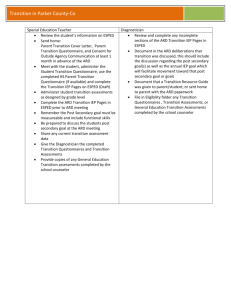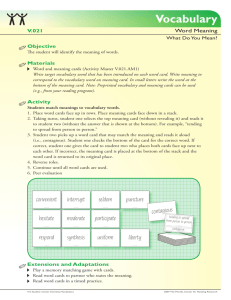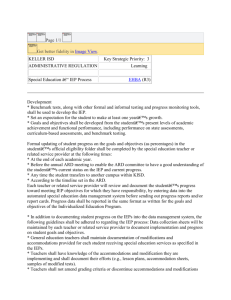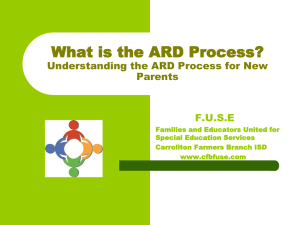File
advertisement
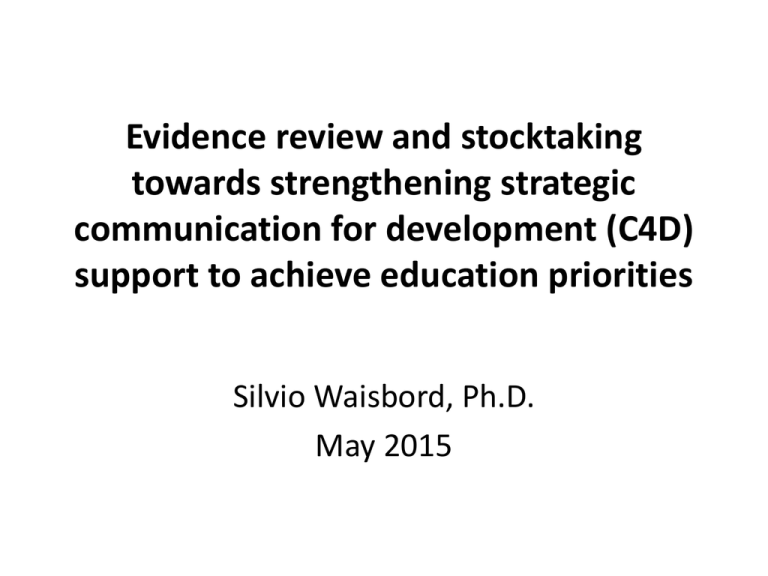
Evidence review and stocktaking towards strengthening strategic communication for development (C4D) support to achieve education priorities Silvio Waisbord, Ph.D. May 2015 Main objective • Conduct a literature review to document and analyze the contributions of communication for development (C4D) to education quality and education inclusion. • C4D is understood as a social process by which knowledge and experiences are shared to promote action that “takes into account the interests, needs and capacities of all concerned” (Servaes 2008). Analytical framework Socio-ecological model - Understand behavioral and social obstacles to change at various levels: 1. Individual/Family: knowledge, attitudes and practices among children and adolescents and families that affect educational decisions and actions. 2. Community: social beliefs and norms, social and economic resources, knowledge and attitudes amongst households, sense of empowerment and collective efficacy that affect educational choices, decisions, and practices. 3. Institutional: institutional conditions of the education system that affect inclusion and quality including educational media. 4. Policy/system: policies and governance elements of educational systems that facilitate and/or discourage inclusive and quality education as well as positive decisions about education amongst individuals and families. Review methodology • Analysis of peer-reviewed studies, books, theses, discussion papers, and project reports published between 2005 and 2015. • Use of mix of four clusters of keywords – Education (“quality education” and “inclusive education”) – C4D – methodologies, strategies/tactics – Socio-ecological model – levels and dimensions – “Marginalization” variables - “disabilities”,” “gender,” “socio-cultural” and “geographical” Plus concepts such as “impact data” and “evaluation” Search engines + databases consulted • Scholar.google. Academic Search Premier; Scopus; DevComm (World Bank); ERIC; ELDIS; United Nations Development Program; United Nations Educational, Scientific and Cultural Organization; Web of Knowledge. Findings • 127 articles and books were selected. • Limited number of documents with impact data from programs and interventions that take an explicit C4D perspective. • Limited number of studies that foreground “behavior change” terminology (e.g. beliefs, attitudes, perceptions, self/collective efficacy), social and community norms, or “social change” framework. • Most of the literature on institutional and policy/systems issues, namely the use of specific C4D approaches related to accountability and community participation. Possible reasons for limited evidence • Limited inclusion of C4D approaches in educational programs aimed at addressing quality and inclusion. • Limited evaluation of C4D program or specific components used by educational programs. • Limited capacity for designing and implementing rigorous evaluations to measure the effects of different C4D components. • Insufficient funding assigned to C4D evaluation in education programming. • Limited presence of behavioral and social change tradition in education programming. Individual and community levels • Limited findings from the search confirm the conclusions of recent studies - research studies are focused on interventions aimed at addressing resource and infrastructure problems more than psychological and social problems. The importance of positive knowledge and attitudes • Awareness about educational options as well as favorable dispositions among children, parents and relatives influence decisions and actions. • Families with negative attitudes are less likely to be supportive, particularly of education for girls, children with disabilities, and migrant and displaced children. • Family decisions to matriculate and keep girls in school are related to their conviction in the value of education and social support. • Community positive beliefs about the inclusion of learners with disabilities in South Africa are deemed critical for the success of inclusive education policies. Create opportunities for community dialogue • Engage communities in questions about quality and inclusive education. • Create safe spaces for dialogue particularly for girls and women (e.g. Afghanistan’s Sada initiative). • Early marriage-prevention messages associated with support for girls’ education among families (e.g. Ethiopia’s Berhane Hewan program). • Community mobilization programs addressing social norms achieved positive impact on girls’ education in Ghana, Kenya, and Malawi. • Egypt’s Ishraq program - community mobilization to raise awareness about the conditions of adolescent girls. Institutional and system levels Impact of C4D on key priorities in educational programming: • community participation • social capital • accountability • ensuring that guidelines and policies address social marginalization • teachers’ capacity • access barriers reducing educational opportunities for specific populations Participatory experiences in schools • Malawi’s Participatory Action for School Improvement (PASI) has made positive transformations in school performance by engaging local communities in a range of activities. • Participatory experiences in Medellin, Colombia have produced significant outcomes. • In Tanzania, a three-year community participation project is credited for making progress towards inclusive and quality education. Limitations of participatory experiences • Participation dominated by educated, political elites or certain ethnic groups at the expense of the whole community. • Partisan interests and patronage have captured participatory processes. • Community participation reduced to simple tokenism or subjected formal participation to special interests. What to do? • Need to consider specific context and local opportunities and resources. • Successful community participation in support of education quality and inclusiveness depends on local populations convinced that participation reflects their needs and can be effective. • If communities are not motivated or convinced that participation would make a difference, then, participation is likely to be low and yield limited results. Strengthen social capital Premise Communities with strong solidarity and trust networks are more likely to develop strong ownership, linkages with schools and develop shared values about children’s education; identify appropriate mechanisms (e.g. flexible learning, support groups, specialized curricula) to address the needs and characteristics of particular children which, in turn, lead to positive education results such as higher matriculation and reduction in dropout. Illustrations • Soul City’s Circles of Support - community sense of responsibility for all children is needed to value schooling and learning performance, fostered through local social networks and interpersonal conversation. • In Malawi, dropout was reduced by 42% in schools where the intervention was implemented compared to non-intervention schools. • In Zanzibar, a program premised on social capital principles successfully raised awareness about needs and educational opportunities, changed attitudes among families and teachers, increased enrollment and retention of children, and strengthened teachers’ capacity to work with children with diverse learning needs. Strengthen accountability Strengthening accountability is closely linked to C4D in two fundamental ways. 1. Information about school performance is critical for communities to learn about schooling rights and responsibilities, functioning, outcomes and other matters. 2. Communities are expected to be actively engaged in decisions particularly as power is devolved to the local level amidst decentralization. Evidence • Promising yet limited results on the accountability of education systems and authorities. • In Indonesia, 400 public primary schools - empowerment of families and school authorities and teachers, better allocation of resources and improve learning conditions that, ultimately, positively affect student learning outcomes. • Community participation in Gambia not only contributed to better representation of parents and accountability, but it also led to improved school facilities. • In India, campaigns aimed at informing communities about roles and responsibility in school accountability produced positive impact in 340 treatment villages in three states. Impact was measured on participation, teacher engagement, and students’ performance. Further evidence • In Malawi, positive impact on parents’ participation, decision-making processes around budget, curricula and other matters that positively affected student learning . • Similar results were observed in Mexico regarding the positive impact on educational opportunities for socially excluded students. • In South Africa, community participation leads to the affirmation of rights-based principles in education services . Influence school guidelines and policies • Participation has critical importance for raising awareness about quality and inclusive educational challenges and influence responses such as specific guidelines, curricula, pedagogy among community members as well as decisionmakers. • A first step is to ensure that communities become aware about specific problems, such as social exclusion of children due to poverty, gender, migration and disabilities. • Participatory methods are valuable to influence policies across a range of issues. Evidence • It is hard to imagine that without awareness about problems communities and schools had taken action, such as implementing “safe spaces” for refugee children, protection for girls in situations of genderbased violence on the way to school and assign itinerant teachers to overcome barriers confronted by children with visual disabilities. • Evaluation assessment have shown positive results in terms of changing teachers’ attitudes and willingness to be attentive to special situations. • In some cases, awareness-raising and participation have contributed to reducing community violence and providing safer spaces for teachers and students. Use C4D tools and approaches to overcome access barriers • In addition to programs such as mobile schools, communities have used media and information technologies to deliver open and distance learning (ODL) to specific groups such as nomadic and pastoralist populations. • ODL allows children to overcome obstacles grounded in geographical isolation and mobility as well as work responsibilities. Evidence • Proliferation of mobile phones and other ICTs in the developing world combined with extensive and successful use in development programs offers unprecedented opportunities for ODL. • Reviews of ODL programs using communication technologies have demonstrated positive results in Botswana Kenya, Nigeria, and Zambia. • Studies show that ICTs not only allow schools to reach children, but they also produce positive educational outcomes including learning and motivation Summary: C4D contributions - promote positive attitudes and norms in support of girls’ education and other groups of marginalized children; - foster community participation to increase accountability and responsiveness of schools through voice and dialogue; - influence school guidelines to attend to the needs of specific groups of children; - provide e-learning opportunities for teachers’ professional development; - offer ODL platforms for reaching children of nomadic and refugee populations. Recommendations 1. Foreground behavioral and 4. Use C4D methodologies social issues in education to promote community programming. assessments and participation. 2. Pair policy interventions with C4D approaches 5. Strengthen evidencethat promote changes in based, strategic, community perceptions community-based and norms. advocacy for quality and inclusive education. 3. Produce nuanced understandings of 6. Integrate strong community participation monitoring and through the use of C4D evaluation plans into methodologies. education programs with C4D components 1. Foreground behavioral and social issues in education programming • Policy approaches need to be complemented with research and programmatic interventions focused on behavioral and social dimensions – knowledge, attitudes, perceptions, self and collective efficacy, social norms – underpinning parents and community education decisions and outcomes. • Mainstream behavioral and social questions that are central to C4D. Significance of behavioral and social issues affecting school attendance, retention and performance such as peer effects, social and economic incentives, and parental attitudes, and call for further attention to these issues. • Formative research into community perceptions and values provides insights to understand socio-cultural and other barriers in households and communities as well as information and perception about schools, education systems, and policies. 2. Pair policy interventions with C4D approaches that promote changes in community perceptions and norms • Comprehensive understanding of barriers to change across multiple levels is the first, necessary step to identify suitable points of entry into a given social problem. • It is recommended to pair policy approaches with interventions aimed at changing social attitudes and cultural values to tackle barriers to quality and inclusive education among marginalized children. • C4D approaches can provide insights into specific community perceptions and norms that contribute to education inequity and different life trajectories in children. • It is important to design multi-pronged programs that aim to support positive community perceptions and norms in favor of quality and inclusive education as well as systembased changes. 3. Produce nuanced understandings of community participation through the use of C4D methodologies • Despite the success of many participatory experiences around the world, other experiences suggest problems. • Need to understand community motivation and (dis)interest as well as ways to overcome problems for participation. • Identify community capacity and resources that can be mobilized in support of education initiatives, including communication platforms and practices. How can C4D contribute? • Get nuanced understanding of barriers and opportunities for promoting participation. • Assess why some communities show higher levels of participation, why certain members in a community are more willing to be engaged in educational issues, and/or why people are more likely to participate. • Understand community norms to inform how programs may tap into positive local values to foster curricula and teaching practices for particular groups of marginalized children. • Identify positive norms in communities to encourage educators to reach and work children of different sociocultural backgrounds. 4. Use C4D methodologies to promote community assessments and participation • Participatory assessments about local conditions that foreground local knowledge and expertise. Conversations about barriers and actions to reach quality and inclusive education, programs can also gain insights into local views about educational systems, school performance, and related issues • Foster participation as bottom-up process rather than as a top-down directive. • Participatory methodologies may also contribute to nurturing social capital, namely trust and solidarity, by bringing together children, parents, teachers, school authorities and other actors. 5. Strengthen evidence-based, strategic, communitybased advocacy for quality and inclusive education Raise awareness among policy-makers and school officials about issues related to educational quality as well as inclusion/disabilities remains a priority for global education. Successful advocacy for sound policies and guidelines demands three conditions. 1. Evidence about conditions to discuss courses of action and demonstrate the value of specific interventions. 2. Strategic thinking to understand and select evidence and arguments that may be effective to engage and persuade certain stakeholders. 3. Broad community coalitions for effective advocacy. 6. Integrate strong monitoring and evaluation plans into education programs with C4D components • Further evidence is needed to understand the contributions of C4D to education programs and inform future programmatic priorities. • Assess interest among various organizations with strong presence in education programming; • Bring awareness about the contributions of C4D and the need of further evidence among actors in the field of global education; • Identify potential opportunities for M&E in current and future programs; • Convene meetings of C4D, education and M&E experts to review experiences in other development fields that can be relevant for C4D in education; • Seek to participate in platforms and initiatives engaged in producing results to demonstrate aid effectiveness.
